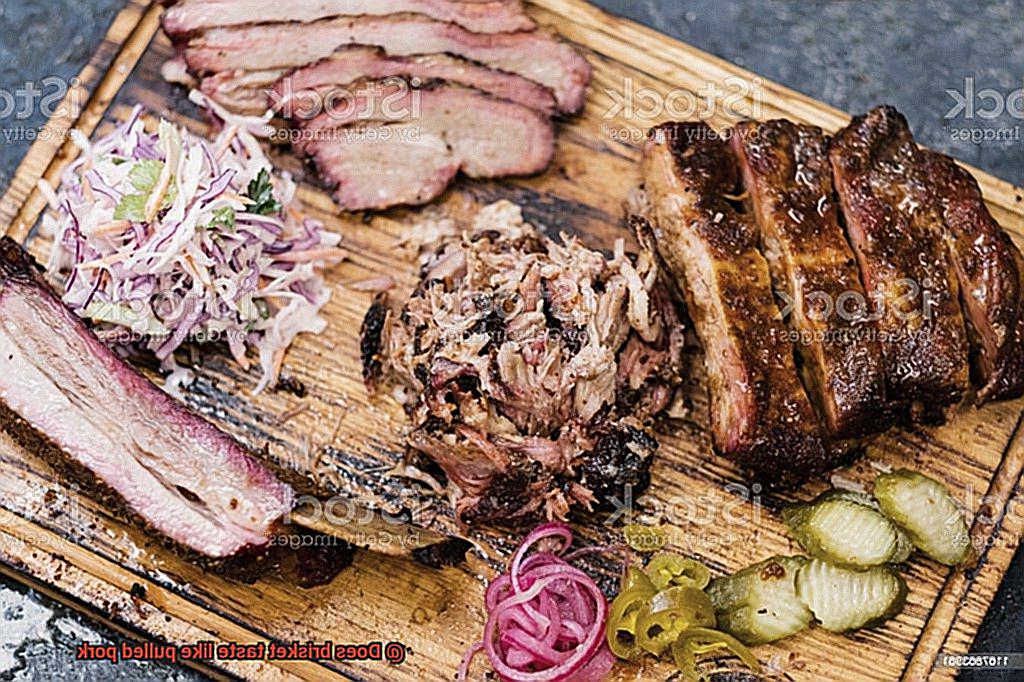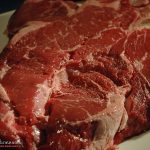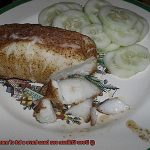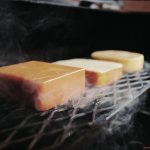Close your eyes and let your senses transport you to a warm summer evening, where the air is thick with the tantalizing aroma of smoky goodness. Your heart races as you approach a table adorned with an array of mouthwatering BBQ delights. It’s a scene that ignites the passion of any food lover. But amidst this carnivorous feast, two heavyweight contenders emerge from the smoke – brisket and pulled pork. Are these meaty powerhouses truly interchangeable?
In this sizzling battle, we’ll unravel the mysteries behind brisket and pulled pork, exploring their distinct flavors, cooking methods, and overall culinary experiences. So get ready, fellow BBQ enthusiasts, as we embark on an epic journey to uncover the truth behind this delectable rivalry.
Brisket and pulled pork may both hail from the rich traditions of American barbecue, but make no mistake – they are far from identical twins. From the succulent tenderness that melts in your mouth when you bite into a perfectly cooked brisket to the juicy, finger-licking goodness of pulled pork, these meats offer unique taste profiles that cater to different palates.
So grab your trusty BBQ tongs and join us as we untangle the complex web of flavors, cooking techniques, and smoky wonders that make brisket and pulled pork true champions in the world of BBQ. Get ready for an explosion of flavors that will reignite your taste buds and deepen your appreciation for these culinary marvels. The battle between brisket and pulled pork is about to commence – hold on tight because it’s going to be one unforgettable flavor-packed ride.
Contents
Comparisons of Flavor Profiles: Brisket vs. Pulled Pork
There is nothing quite like the intoxicating aroma and mouthwatering flavors of perfectly grilled or smoked meats, especially when it comes to BBQ classics like brisket and pulled pork. These two dishes have rightfully earned their place as fan favorites in the grilling world, each offering its own unique and delightful flavor profile. Let’s dive into the world of BBQ and compare the distinct tastes of brisket and pulled pork.
Brisket: The King of Beefy Goodness
Brisket, sourced from the chest area of a cow, boasts a rich, beefy flavor that delights meat lovers everywhere. Its slow cooking process allows the fat to render and infuse the meat with a deep, smoky taste. The exterior bark formed during smoking adds a touch of charred goodness to its flavor profile. When sliced against the grain, brisket is both tender and firm, creating a satisfying chew that meat enthusiasts adore.
Pulled Pork: A Symphony of Sweetness
Made from pork shoulder or butt, pulled pork offers a milder yet equally tantalizing taste experience. The slow-cooking method employed in its preparation allows the fat to melt, resulting in moist, juicy meat. The use of barbecue sauce or dry rubs during cooking adds a tangy and slightly sweet element to its flavor. Pulled pork is shredded into succulent strands that effortlessly melt in your mouth, making it an irresistible choice for those seeking tender and flavorful meat.
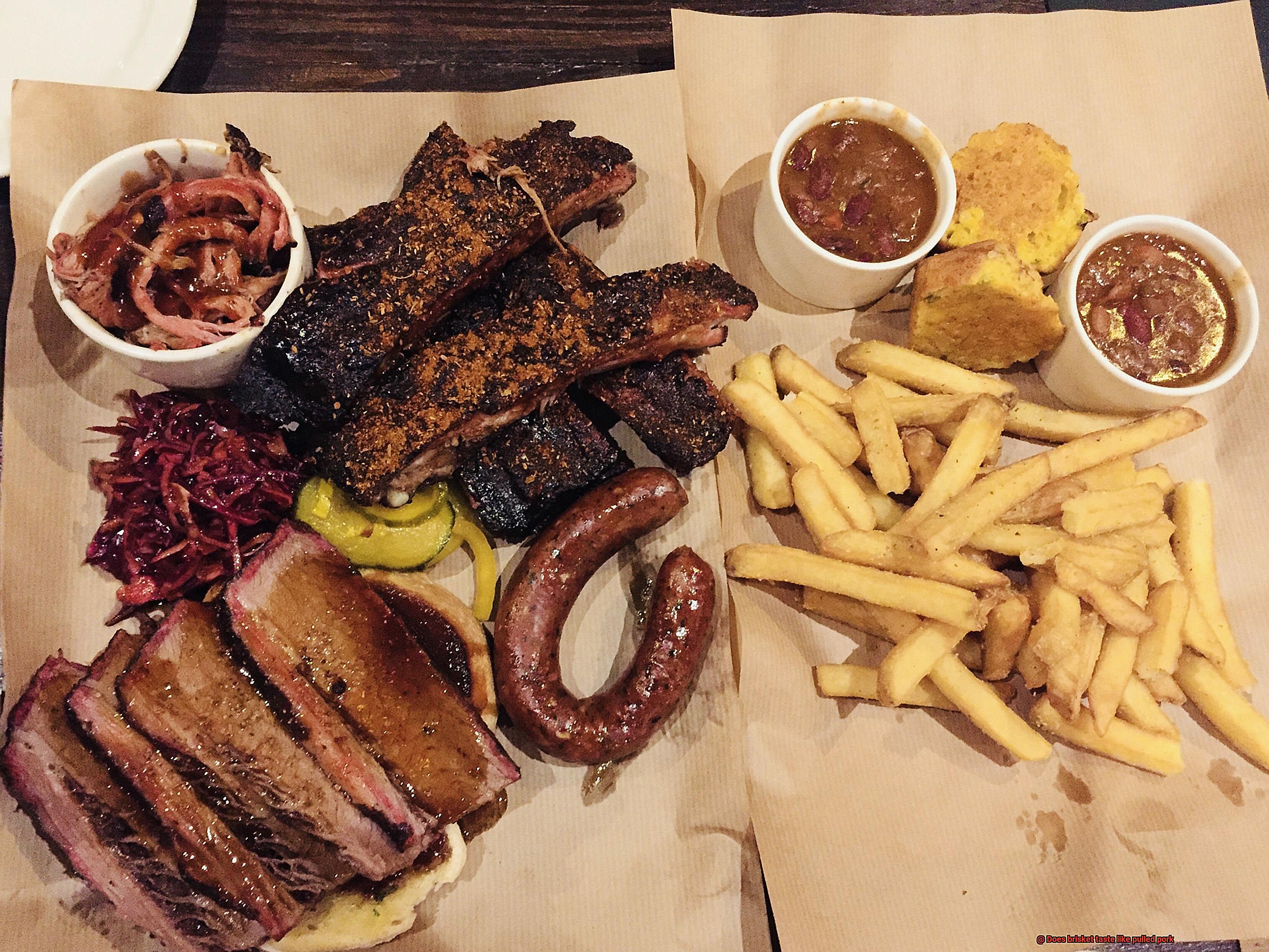
Comparing Brisket and Pulled Pork:
Meat Flavor:
- Brisket: Bold, beefy taste.
- Pulled Pork: Milder, pork-centered flavor with subtle sweetness.
Smokiness:
Texture:
- Brisket: Firm, yet tender slices.
- Pulled Pork: Soft, easily shredded strands.
Tips for Grilling Enthusiasts:
- Choose your meat: Consider personal preferences and dietary restrictions when deciding between brisket and pulled pork.
- Marinate and season: Enhance the flavors of both meats by marinating them overnight or applying dry rubs before grilling.
- Master the cooking techniques: Learn the art of low and slow cooking to achieve the perfect tenderness and smoky flavor for both brisket and pulled pork.
- Pair with sauces and sides: Experiment with different BBQ sauces and complement your meat with delicious sides like coleslaw, cornbread, or baked beans.
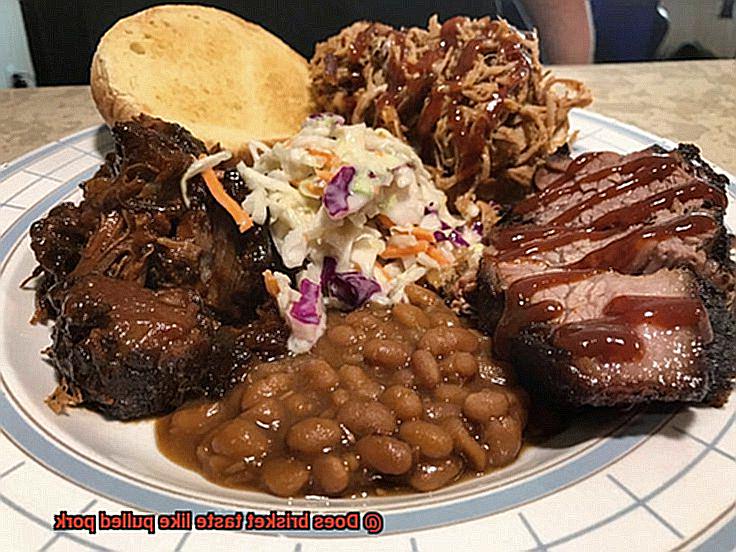
The Texture Difference between Brisket and Pulled Pork
In this guide, we will explore the texture difference between two popular meats: brisket and pulled pork. Whether you’re a seasoned griller or just starting out, understanding the unique textures of these meats will help you create delicious and memorable BBQ dishes.
Brisket:
Let’s start with the king of beefy goodness—brisket. Sourced from the breast or lower chest area of the cow, this cut of beef boasts a rich flavor and a tender, melt-in-your-mouth texture when cooked to perfection. When prepared low and slow, brisket develops a beautiful crust on the outside while retaining its juiciness and tenderness inside. The breakdown of collagen during cooking results in a soft and succulent texture that is simply irresistible. The marbling of fat within the meat adds an extra dimension of richness, enhancing the overall mouthfeel.
Pulled Pork:
Now, let’s turn our attention to the symphony of sweetness—pulled pork. Typically made from pork shoulder or pork butt, this versatile meat can be cooked in various ways such as smoking, roasting, or braising. Pulled pork gets its name from the method of preparation, where the meat is slow-cooked until it becomes so tender that it can be easily shredded or “pulled” apart.
The texture of pulled pork is characterized by its delicately stringy and fibrous consistency. The long cooking time breaks down the connective tissues in the meat, resulting in a texture that falls apart with minimal effort. It’s no wonder why pulled pork is perfect for sandwiches or tacos.
Comparing Textures:
While both brisket and pulled pork are incredibly flavorful, their textures differ significantly. Brisket has a more solid and substantial texture due to its beefy nature. It offers a satisfying chew that is complemented by its tender juiciness. With each bite of perfectly cooked brisket, you can feel the meat’s resistance before it yields to your teeth, releasing its delectable flavors.
On the other hand, pulled pork has a softer and more delicate texture due to the breakdown of collagen in the pork shoulder. Its fibrous strands effortlessly melt in your mouth, creating a delightful experience. The texture of pulled pork is akin to a velvety cloud dissolving on your tongue, leaving behind a symphony of smoky sweetness.
Cooking Techniques for Brisket and Pulled Pork
Today, we delve into the tantalizing cooking techniques for brisket and pulled pork, unlocking their distinctive flavor profiles and sharing invaluable tips and tricks to help you achieve unparalleled succulence on your grill.
First up, let’s explore brisket, the undisputed king of beef cuts. Renowned for its robust flavor and tender, juicy meat, brisket demands a low and slow approach to transform its tough fibers into a succulent masterpiece. The most popular method for cooking this regal cut is smoking. By slow-cooking the meat over indirect heat with wood chips or charcoal, you infuse it with a smoky essence that perfectly complements its natural beefiness. Remember, patience is paramount. Maintain a temperature of around 225-250°F (107-121°C) for several hours, allowing the internal temperature to reach approximately 195-205°F (90-96°C) before carving into it.
Pros:
- Smoking imparts an enchanting smoky flavor to the brisket.
- Slow cooking tenderizes the meat by breaking down connective tissues.
- A well-smoked brisket develops an alluring crust that adds depth to each heavenly bite.
Cons:
Brisket can be quite costly.
Now, let’s turn our attention to pulled pork, a culinary marvel crafted from either pork shoulder or pork butt. While pulled pork can also be smoked, it’s commonly prepared using the “low and slow” technique in a smoker or slow cooker.
Coated with a tantalizing dry rub or marinade, the pork is cooked at a gentle temperature of around 225-250°F (107-121°C) for several hours until its internal temperature reaches a mouthwatering 195-205°F (90-96°C).
This unhurried process allows the collagen in the meat to break down, resulting in tender, succulent pulled pork that effortlessly yields under your fork.
Pros:
- Slow cooking produces exquisitely tender and flavorful meat.
- Pulled pork is an incredibly versatile ingredient, lending itself to a myriad of culinary creations.
- Even if you slightly overcook it, pulled pork can still dazzle taste buds with its deliciousness.
Cons:
- Cooking time can be quite lengthy, demanding unwavering patience.
- Achieving consistent texture throughout the meat can prove challenging.
- Pork shoulder or butt may have higher fat content.
Seasoning Techniques to Enhance the Flavor of Brisket and Pulled Pork
Prepare to embark on a journey of flavor as we unlock the secrets to transforming brisket and pulled pork into culinary masterpieces. Seasoning is the gateway to unlocking the mouthwatering taste profiles of these meats. In this article, we will explore various seasoning techniques that will elevate your barbecue game to new heights. From dry rubs and marinades to the art of wood smoking, get ready to take your brisket and pulled pork to a whole new level of deliciousness.
The Allure of Dry Rubs for Brisket:
In the realm of brisket, dry rubs reign supreme. A symphony of flavors awaits as you blend salt, pepper, garlic powder, onion powder, paprika, and your choice of spices. Massage this tantalizing mixture into the meat, allowing it to permeate and create a crust that bursts with flavor when cooked. This simple yet effective technique will leave your brisket with an irresistible taste and a texture that melts in your mouth.
Marinating: A Gateway to Brisket Bliss:
For an extra dose of flavor, consider marinating your brisket. Imagine a tantalizing combination of soy sauce, Worcestershire sauce, vinegar, honey, and spices working their magic on the meat. Allow the brisket to luxuriate in this flavorful concoction for several hours or even overnight. The marinade will infuse the meat with tenderness and enhance its overall taste, resulting in a truly unforgettable dining experience.
Wet Marinades or Injections for Pulled Pork:
Pulled pork enthusiasts can embark on a flavor adventure with wet marinades or injections. Picture yourself injecting a heavenly mixture of apple cider vinegar, mustard, brown sugar, Worcestershire sauce, and spices into the pork using a syringe or basting it with a delectable marinade. These techniques will keep your pork moist during cooking, while layering flavors that will make your taste buds dance with joy.
Unleashing Flavor with Dry Rubs for Pulled Pork:
Never underestimate the power of a well-crafted dry rub when it comes to pulled pork. Imagine harmonizing paprika, chili powder, cumin, brown sugar, garlic powder, and other spices that tickle your fancy. Massage this flavorful blend onto the pork shoulder or butt, allowing it to create a crust that adds both tantalizing flavor and a delightful texture to your pulled pork.
Marbling in Brisket vs. Fat Content in Pulled Pork
Immerse yourself in the smoky allure of the grill, where tantalizing flavors intertwine and dance on your taste buds. Today, we embark on a culinary journey to delve into the mouthwatering differences between marbling in brisket and the fat content in pulled pork. So, grab your tongs and let’s uncover the secrets to barbecue bliss.
Casual Comparison:
Marbling in Brisket:
Imagine uncovering nature’s hidden treasure, tiny pockets of flavor tucked away throughout the meat, waiting to explode with tenderness in every bite.
Fat Content in Pulled Pork:
Ah, the glorious fat. It’s like the secret ingredient that takes pulled pork from good to absolutely mouthwatering, delivering succulence and flavor in every mouthful.
Professional Insights:
Marbling in Brisket:
- Even distribution: Picture a symphony of marbled fat, evenly dispersed throughout the meat, resulting in a melt-in-your-mouth texture when cooked to perfection.
- Enhanced flavor: As the brisket cooks, the delicate fat melts, infusing the meat with a rich and buttery taste that lingers on your palate.
- Moisture retention: The marbling acts as a guardian of moisture, ensuring that each slice is juicy, tender, and utterly satisfying.
Fat Content in Pulled Pork:
- Concentrated goodness: The fat content in pulled pork is more concentrated, slowly rendering down during the low and slow cooking process. This creates a succulent masterpiece that envelopes the meat with its unctuousness.
- Juicy and savory: The high-fat content contributes to pulled pork’s juiciness, allowing each bite to burst with savory flavors that leave you craving for more.
Engaging Experiences:
Close your eyes and envision sinking your teeth into that perfectly grilled brisket, where marbled fat creates an explosion of juiciness that dances on your tongue. Or perhaps you prefer the allure of pulled pork, where each bite is a symphony of tender meat coated in a rich, savory glaze. Whichever path you choose, both offer distinct taste experiences that will transport you straight to barbecue heaven.
Smoking Techniques for Brisket and Pulled Pork
Today, we’re delving into the smoking techniques for two BBQ classics: brisket and pulled pork. Get ready to tantalize your taste buds with flavors that will make your mouth water and meat that melts in your mouth.
Let’s start with brisket, the king of BBQ cuts. This majestic piece of meat is packed with flavor potential. To ensure your brisket reaches its full potential, choose a quality cut with a thick layer of fat on top. This fat will render down during cooking, infusing the meat with moisture and flavor.
Before tossing that bad boy onto the smoker, generously season it with a dry rub. This will add an extra punch of flavor to every bite. Now, it’s time to fire up the smoker. Set the temperature to around 225-250 degrees Fahrenheit for that low and slow cooking method that melts away those tough connective tissues. And don’t forget to throw in some smoke wood chips or chunks for that irresistible smoky aroma.
Keep a watchful eye on the internal temperature of your brisket using a meat thermometer. Once it reaches around 195-205 degrees Fahrenheit, it’s time to remove it from the smoker. But hold your horses. Let that beauty rest for at least 30 minutes before slicing into it. This allows those precious juices to redistribute within the meat, resulting in a tender and flavorful bite that will leave you craving more.
Now, let’s move on to pulled pork, a BBQ delight that oozes smoky goodness. Pork shoulder or pork butt are the stars of this show, thanks to their marbled fat and collagen-rich composition. To maximize flavor absorption, season your pork with a dry rub and let it hang out in the refrigerator for a few hours or even overnight.
Just like brisket, pulled pork requires that low and slow cooking technique. Set your smoker to the same temperature range of 225-250 degrees Fahrenheit, and let the magic happen. Indirect heat and smoke wood chips or chunks will ensure that every bite is bursting with smoky goodness.
Now, here’s where patience comes into play. Pulled pork takes a bit longer to cook than brisket, as those collagen strands need some extra time to break down. Keep a close eye on the internal temperature with your trusty meat thermometer, and once it hits that sweet spot of 195-205 degrees Fahrenheit, it’s time to take it off the smoker.
But wait. Before you dig in, give that pulled pork a well-deserved rest for at least 30 minutes. This allows the juices to redistribute throughout the meat, resulting in tender and succulent strands that practically melt in your mouth. Grab two forks or get your hands dirty and start shredding that pork like a true BBQ aficionado.
Personal Preferences in Taste
When it comes to the world of BBQ, personal preferences in taste can make all the difference. It’s what sets us apart and makes our grilling adventures unique. One question that often arises is whether brisket tastes like pulled pork. Well, my fellow grill enthusiasts, let’s dive into this debate and uncover the various factors that can influence our perception.
First things first, let’s talk about the cuts of meat. Brisket comes from the lower chest or breast of the cow, while pulled pork is typically made from pork shoulder or butt. These different cuts result in variations in taste and texture. Brisket boasts a rich, beefy flavor, while pulled pork tends to be slightly sweeter and milder.
But it doesn’t stop there. The cooking techniques for both meats also play a significant role. Brisket is slow-cooked at a low temperature for an extended period, resulting in a tender and flavorful meat. On the other hand, pulled pork is cooked until it reaches a point where it can be easily shredded. These distinct cooking methods contribute to the unique characteristics of each dish.
Let’s not forget about the seasoning and sauce. Different regions and individuals have their preferred rubs, marinades, or sauces that can significantly alter the flavor profile of the meat. From savory to sweet, tangy to smoky, these choices can take your BBQ experience to a whole new level.
Now, here’s where personal preferences truly come into play. Your cultural background, regional cuisine, and individual palate sensitivities can heavily influence your taste preferences. Some folks may prefer the bold and smoky flavors of brisket, while others might find themselves drawn to the sweet and tangy taste of pulled pork.
At the end of the day, whether brisket tastes like pulled pork is subjective. It ultimately depends on your own taste buds and what you find appealing. So, my advice? Try both meats separately to fully experience their unique flavors. Explore the nuances, savor the tenderness, and let your personal preferences guide you on this mouthwatering journey.
8Er9Hdnd50Q” >
Conclusion
In conclusion, it is clear that brisket and pulled pork have distinct flavors that set them apart.
While both are delicious in their own right, they offer unique taste experiences. Brisket is known for its rich and smoky flavor, with a melt-in-your-mouth tenderness that is hard to resist.
On the other hand, pulled pork boasts a tangy and savory taste, often enhanced by the use of barbecue sauces or rubs. These differences make it difficult to say that brisket tastes like pulled pork.
Each dish has its own loyal following, with enthusiasts who appreciate the specific qualities that make them stand out.

